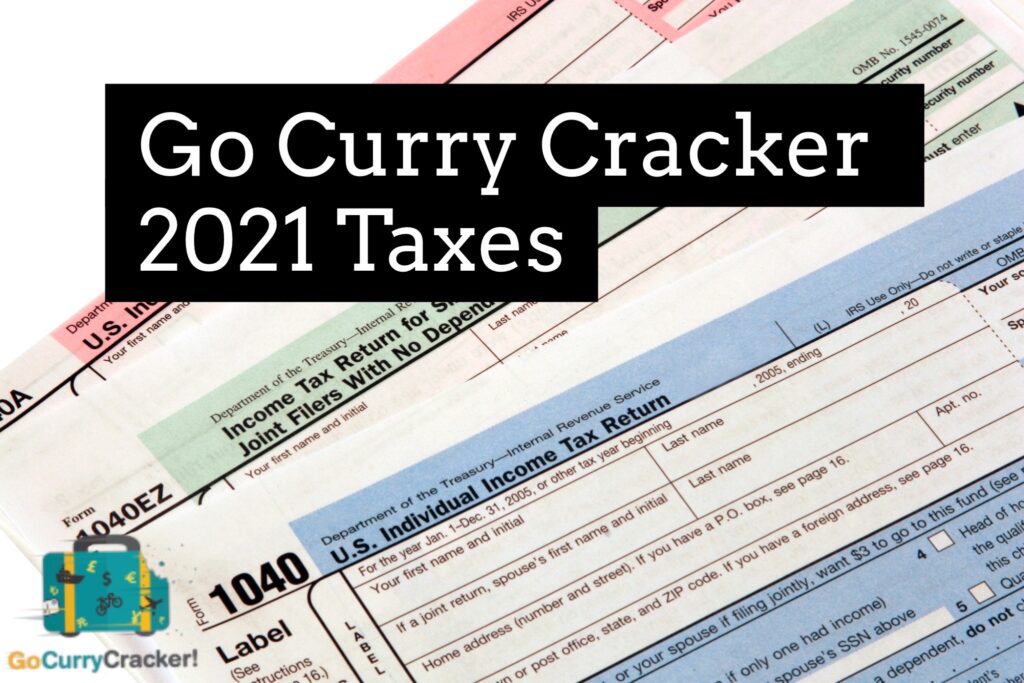After a decade of zero and near zero tax bills, our 2021 tax return looks a bit different – We paid a LOT of tax.
No surprises though – I sold a ton of stock to pay cash for a house. In the grande scheme of things it is no big deal.
I’ll break it all down below (with links) and highlight some things I did to minimize taxes this year and going forward.
The Go Curry Cracker 2021 Taxes
Aside from realizing some substantial capital gains, 2021 was a fairly normal income and tax year for us.
Total income for the year was $408,465, of which 80% comes from selling stock to fund a home purchase (plus some extra, more on that later.) 100% of our tax bill for the year comes from this transaction. The IRS is very generous to early retirees, but less generous for large lump-sum transactions.
The marginal income tax rate (on additional income) was 18.8% for qualified income (15% capital gains tax rate and 3.8% NIIT tax rate) and ~26% for ordinary income, with an effective (overall) tax rate of 8.0%. Total income tax was $32,832.
Because I violated Rule #1, Choose Leisure over Labor, I paid $5,472 in self-employment taxes (sort of an involuntary annuity purchase.) This brings the effective tax rate to 9.4%
Because selling a lot of stock lost us some benefit of the expanded child tax credit ($2,600 total, a 5% effective tax rate during the phase-out), our real effective tax rate is closer to 10.0%.
Key to getting the numbers right is a good tax tool. For example a calculator that understands the beauty of tax-free Roth conversions and Capital Gain Harvests. I have written such a calculator:
GCC Income Tax Calculator
Or you can go wild with an all-encompassing tax spreadsheet, such as this one.
But let’s get on with it. Here is the stuff we sent to the IRS:
Form 1040
- Income
- Gross Income: $386,682 (Line 9)
- Foreign Earned Income Exclusion: $21,783
- Adjusted Gross Income: $366,725 (Line 11)
- Solo-401k Traditional contribution: $13,250
- HSA contribution: $600
- Taxable Income: $341,625 (Line 15)
- Tax:
- Income Tax: $42,391 (Line 16)
- Self-employment Tax: $5,474 (included in Line 23)
- NIIT: $5,263 (included in Line 23)
- Tax Credits: $14,822 (Line 21)
- Child Tax Credit: $700 (Line 19 – already received payments throughout 2021.)
- Foreign Tax Credit: $1,092
- Residential Energy Credit: $5,460
- Qualified plug-in motor vehicle credit: $7,500
- Credit for child and dependent care expenses: $70
- Income tax after credits: $27,569 (Line 22)
- Total tax: $38,306
This is how it all looks on the 1040 ->
Saving $50,000 in tax on stock sales
We sold a lot of stock in 2021. Those stock sales took place in 2 parts (all prior to moving to California, so $0 in state tax.)
First, I sold stock to secure cash for a home purchase.
This first transaction resulted in realized long-term capital gains of ~$240,000 USD on a sale of something like ~$900,000+
Tax on a gain of this magnitude are fairly reasonable, about $32,000 (13%-ish as some is taxed at 0%) plus another $2,000 in NIIT (a 3.8% additional tax on a portion of the gain.)
When making a home purchase paying 3% plus or minus is in the range of reasonable negotiation.
But there is a real beauty to this transaction that isn’t clear from the tax forms. Had I done zero capital gain harvests over the past 8 years, our actual realized gain for the same purchase would have been $327,000 greater. Now our tax bill (capital gains and NIIT, combined) is a rather large ~$85,000. Thank you to my previous self for saving us ~$50,000.
Want to know more about how this works? Plug your email address in here and I’ll send you our capital gain harvesting template based on actual transactions.
Saving future taxes on stock sales (probably)
The second stock transaction was the sale of an additional ~$150k, pushing income up to just below the Child Tax Credit phase-out (still had room at the upper range of the 15% capital gain tax bracket.)
This resulted in an additional ~$95,000 in realized gains. All of this was taxed at 18.8%, for a total tax of ~$18,000.
I then immediately repurchased the same $150,000 worth of stock. The $18k tax bill wasn’t due until nearly a year later.
I now have about $150k worth of stock at full basis (less with market volatility and with but $18,000 less cash, 12%+ of the stock value.)
Why on earth would somebody in their right mind choose to do such a thing? (Good question!)
I discussed this at length (here) but the key points are:
- This is a one-time thing, at a point in time where I am transitioning from a very tax-friendly locale (International) to a less tax-friendly locale (the US, with ACA health insurance, in California.)
- These are funds that will be used in the near-term (<5 years) and 18.8% is likely the lowest tax rate I will ever see on a stock sale, but potentially much MUCH higher
Important point: this is most likely less advantageous than borrowing. See: Sweet, Sweet, Debt
(I’m doing both. Hedging)
Refundable Tax Credits
There are 2 non-refundable tax credits I took advantage of this year that I am unlikely to qualify for ever again (due to low income.)
First, we bought an EV which qualifies for a $7,500 tax credit. It’s nice. To qualify you must first have a tax bill larger than $7,500, which is unlikely to be the case for us going forward.
Second, we installed solar panels on the house which qualifies for a 26% tax credit. Plus, our electric bill for the past 2 months has been negative.
Combined these credits wipe out over $13,000 worth of tax (about the equivalent of my massive capital gain harvest.) (Of course, I already calculated the ROI of solar and buying an EV based on the credits, so no double counting.)
Foreign Earned Income Exclusion
For the last time (probably) we again used the Foreign Earned Income Exclusion on Form 2555. This excludes ~$22,000 of income earned outside the US prior to our return. That saves about $2,200 in tax (Line 5 below.)
Normal Traditional 401k / IRA / HSA Contributions
Since we returned to the US in August, I was able to exclude all prior earned income with the FEIE. But all income as US / California residents was taxed as normal and based on having very high income. As such, the marginal tax rate on that income was high.
I contributed nearly 100% of US earned income into my solo 401k to reduce both US and California taxes. I also contributed to an HSA for the one month we had a qualifying HDHP family plan.
(I also have a calculator for determining correct solo-401k contributions.)
Additional Nuance
Throughout the year I paid estimated taxes for all self-employment taxes.
I paid the tax due on capital gains in April 2022 even though the transactions took place in July 2021. I paid zero penalty or interest thanks to the IRS safe harbor rules.
And of course, some of these payments were made on credit cards to get the generous welcome bonuses. In some cases, a tax payment was the only transaction ever made on a card. This is a great way to get some “free” vacations, e.g. we just got back from a week in Hawaii where we paid $11 in taxes per person for the flight and roughly $30/day (resort fees) for a large suite in one of the most expensive hotels in Oahu. I actually made this year’s tax payments poolside just before the rainbow came out.

We went to Hawaii and all I got was a sun tan and this lousy photo. More on Instagram.
For more details, see: Paying Taxes with a Credit Card.
A good card to get started is this one, now with a new higher welcome bonus:
Great welcome bonus
 The Chase Sapphire Preferred is the best card for beginning travel hackers!
The Chase Sapphire Preferred is the best card for beginning travel hackers!Summary
We paid a lot of tax this year, although as a percentage of income it was still pretty low thanks to a decade of low/no tax capital gain harvests. It was also low as a percentage of total home purchase price.
100% of our tax bill this year came about as a result of selling stock to pay cash for a house. Had we continued our international lifestyle, this year would have been much like prior years with a $0 tax bill.
Additional tax was realized when harvesting massive gains in order to minimize taxes in our new less-tax friendly home over the next couple of years.
Since this is the only foreseeable year in which we will have a large tax burden, we timed purchases to take advantage of several nonrefundable tax credits. This reduced our tax bill by over $13,000. Since our marginal tax rate was temporarily high on ordinary income, I also contributed to 401k and HSA.
Overall, our total tax burden was less than 10% which seems reasonable as a one-time transition.







My favorite type of GCC post. Taxes. Tasty.
One question. Why not pre-arrange a mortgage and buy using debt rather than sell stock, buy a house, and then set up the mortgage? Was it just to make your bid on the house more competitive as an all cash buyer?
Couldn’t you have avoided having that massive all at once sale of stock triggering the taxes buy just arranging a traditional mortgage?
It was for exactly that reason, the bidding on houses in California is no joke.
“We were outbid and outmaneuvered on multiple properties prior to this so I changed to an all-cash offer and quick close to be more competitive.”
Details in this post:
https://www.gocurrycracker.com/our-forever-home/
But also… a (large) traditional mortgage has its own implications. If I borrowed $1 million in order to sell zero stock I would need to cashflow $48k+/year in mortgage payments… maybe 2x or more our cost of living. All of that realized income is taxed by California (no 0% capital gain tax rate) and reduces ACA subsidies. It also impacts flexibility – if the market dropped 50%, I still need to make mortgage payments and could be forced to sell stock at lows to do so.
Marginal tax rate wise, I would be paying 4-8% to California and 15% to the ACA for a minimum 19% rate (vs 18.8% now.) I would also lose ACA cost sharing subsidies (saves a few thousand per year) and worst case lose subsidies entirely (cost about $12k/year.) Plus I would be paying ~3% annually in interest costs.
Or… I just try to negotiate a 3% price difference in the home purchase and trade stock market for real estate market appreciation/volatility.
I don’t know what is the most optimal solution, but I’m OK with where we ended up – especially now as I sold all of that stock at higher prices than current market :p
Two posts I wrote about this:
Going Back to Cali…? – explores impact of ACA and CA tax systems
Rent vs Imputed Rent – explores paying rent/mortgage vs having a paid off home
Long time reader. Really appreciate all of the great contents. My wife and I are planning our steps to FIRE but have some questions regarding to healthcare. How do you plan/budget for long-term illnesses like cancer during FIRE? What insurance / savings do you guys have while living in the U.S.? And had in Taiwan? ( We might be following your guys’ footstep and move to Taiwan for FIRE :) Thanks in advanced for any advice.
Insurance.
ACA or Medicare in the US, National health insurance in Taiwan (a Medicare for all type system.)
Why did you move to California as opposed to a lower / no income tax state with cheaper housing like Texas.
You could have gotten a fixed rate HELOC loan also.
Because I like California and don’t like Texas.
I would also pay more tax in Texas.
This sounds like a blog post is needed. I’m under the assumption CA is a high tax state and TX is not.
Texas works hard to perpetuate this assumption.
But they have one of the highest property tax rates in the country. If you are in the top 5% of income earners and you live in a modest home, Texas is good for you (in tax terms, maybe not so good in other ways.)
If you are in the bottom 95% of income, like we are, you fare better in California.
I didn’t read this article but it was the first that came up on Google:
https://www.bloomberg.com/opinion/articles/2021-05-19/wait-california-has-lower-middle-class-taxes-than-texas
You could secure a loan base on your stock holdings. The refinance a mortgage with cash out to pay for the loan. Then you would have to realize cap gain and paid tax. Also mortgage also could use as tax deduction.
I don’t pay enough interest to deduct the mortgage in any case.
It looks like you might have been able to contribute $7200 to an HSA (and then deduct $7200) under the HSA last month rule instead of $600.
Hmm, looks like. Thanks, this is the first I’ve heard of this.
any thoughts into taking a margin loan instead of cashing out? brilliant post as usual
Maybe GCC has a different view, but personally while I think its ok to use margin for the short term purchase, but you don’t really want long-term assets funded with short-term debt.
An asset-backed mortgage loan that GCC took is similar to a margin loan, just that it is suited to a home being fixed rate.
Would’ve had to sell some shares either way to meet LTV requirements.
Depends on how big the margin loan is.
Any debt that is callable is dangerous. The higher the debt load, the greater the risk. It would suck to be forced to sell near the bottom.
CA state tax and property tax?
Yes
We paid about $1k in CA income tax. Only CA sourced income is taxed but at a rate based on earning 100% of income here. Our effective rate was around 7%.
Property tax rates are ~1%
Great Article. Congrats on minimizing your tax bill! Do you have privately purchased health insurance! If so, did you get to deduct the premiums from your self-employment income?
Yes. Deducted
Wow! We envy your ability to weigh all your options and make such important decisions so quickly!
You may have covered this in your blog before, but I would like to hear more about how you are able to consider so many complex variables at the same time.
Juggling multi-variable complex systems was my daily grind for 20 years as an engineer. The tax code is fairly basic by comparison.
Most of this stuff I just think through one piece at a time, typically in Excel.
You are way too modest, we have friends that are tax attorneys who don’t understand some of these basic concepts and are working into their 60’s and 70’s because “they need the money” and will never retire.
As a former business analyst, spreadsheets have been my go to as well but there is still something about discussing scenarios out loud with like minded people. Since I have been retired I am hard pressed to find locals like us to discuss investing much less tax optimization because they are too busy working for an hourly wage.
That is why we appreciate your blog and have learned from the information you post.
Thanks for the great post!
Did you qualify for the QBI deduction? (Maybe you were phased out with your AGI)
phased out. It was small anyway
The US tax system seems to be overly complicated for individuals. In most countries you can do all this online, using a government website and data collected from banks and financial institutions. The only data you then have to provide is business done in cash or through barter. Having a lot of different types of deductions is skewing the system to give people with higher incomes more opportunity to receive lower taxes than low income earners, making it less fair.
Yes?
Something for Everybody
Nice post! Thanks for sharing!
Quick question. How do you pay only $5,400 in taxes on your blog if your annual income is $39,000? Seems very low considering there are probably no much business deductions on online business.
The self-employment tax alone is 15% plus federal, state. What’s the math on this?
Profit is ~$39k. That is after deductions.
Math is ~$39k * .9235 * 15.3% = ~$5,400.
Our self-employment tax calculator goes through the details.
For income tax, about half was not taxed due to the FEIE.
A large part of the rest was not taxed due to a Traditional solo-401k contribution.
The remainder was not taxed due to the standard deduction.
Have you thought about what kind of approach you’d take in the gap between having dependents to easily qualify for ACA subsidies and Medicare.
The cutoffs for the juicy <200% FPL subsidies drop to $36k for a couple. Which can be a little difficult to get under on a lifestyle similar to yours.
Let's say you didn't have any blog income and had your money split 50/50 between traditional and roth.
Would you continue try to maximize ACA subsidies or go above that threshold and do more conversions to avoid rmd/ss tax bombs later?